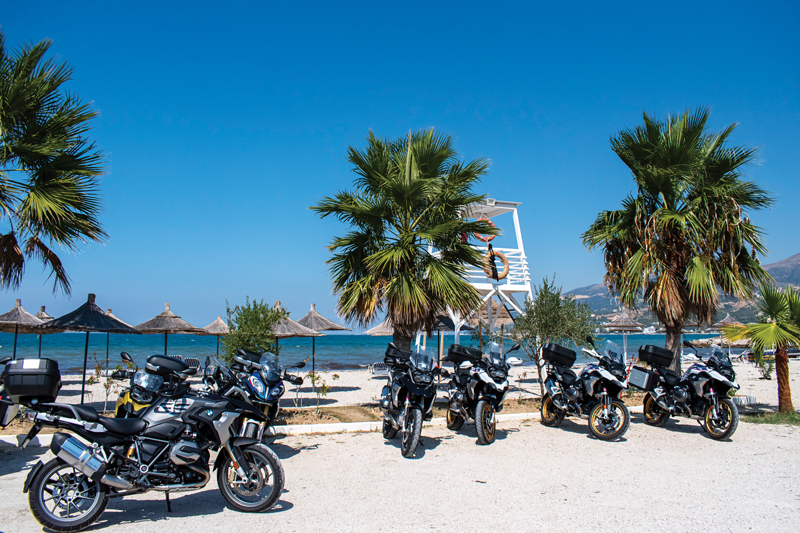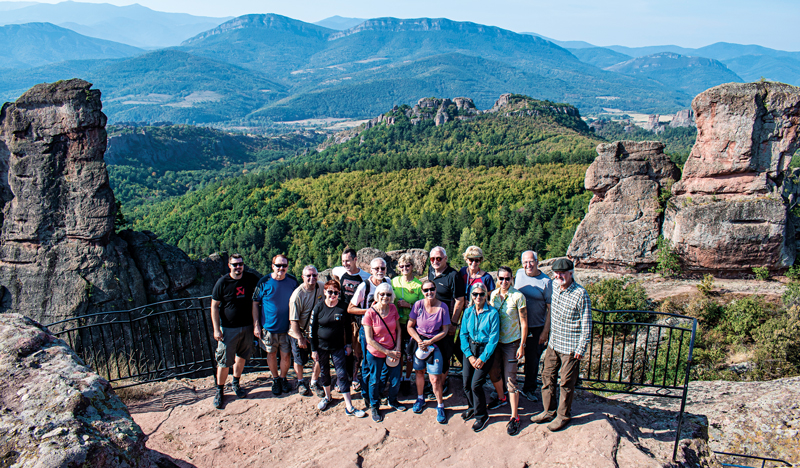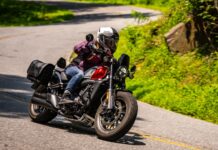The Balkan region has had a hand in world history more often than you might think. Thanks to its geographical position, it’s always been a crossroads of culture, where farming first spread from the Middle East into Europe during the Neolithic era, and as the convergence point of Latin and Greek influence, Orthodox and Catholic Christianity, and Islam and Christianity. It’s been home to Goths, Huns, Slavs and Ottoman Turks, among many others.
For riders with an adventurous streak, the Balkans are also a fascinating place to explore, well off the beaten tourist track, where surprisingly entertaining roads with very little traffic will carry you through magical forests, along jade-colored rivers, over high mountain passes and past farm fields where workers still till the soil by hand. I first traveled to the Balkans with Adriatic Moto Tours (AMT) in 2017 (read about that here), visiting Slovenia, Bosnia and Croatia, and was smitten by the culture, history, friendly people and, most importantly, the amazing roads. So this time I opted for a longer, even more adventurous getaway that would complete my tour of the former Yugoslavia — Serbia, North Macedonia and Montenegro — as well as allow a visit to two “behind the Iron Curtain” countries, Bulgaria and Albania, and a unique opportunity to get a passport stamp from a rather controversial country, Kosovo.

The Intriguing Southeast Europe tour begins and ends in Belgrade, Serbia, a bustling city that sits at the confluence of two mighty rivers, the Danube and the Sava. I arrived a day early to acclimate and explore the city on my own, which I highly recommend. Belgrade, like most European cities, is very walkable and there are several interesting museums and points of interest, including an air museum that features pieces of a U.S. F-117 stealth fighter and an F-16 that were shot down during the 1999 campaigns, a monument to the Jewish and Roma victims of a Nazi concentration camp that once sat on the riverbank (Yugoslavia was occupied by the Nazis during WWII but its people resisted valiantly and were ultimately successful in driving them out) and the Museum of Yugoslav History, burial place of dictator Josip Tito. Most of the people I interacted with spoke English, and all were friendly.
The Serbs that I met tended to be very open and matter-of-fact, and it’s clear the events of 1999 are still quite fresh in their memories. At dinner the first night, only hours after I’d arrived, two young men at the next table overheard me speaking English and they turned and introduced themselves. “I am a riverboat captain,” said one proudly. “It’s good money, more than fifty thousand per month.” He meant 50,000 Serbian dinar, which is equivalent to approximately $475. He then went on to give me his opinions on why Serbia was struggling economically and how strong Yugoslavia once was. He thought the U.S.-led NATO bombing was unethical and misguided. At the end of our conversation, he and his companion warmly bid us good night and bought us a round of drinks. If only all discussions were so civilized.

The second night, after a long day of walking and exploring, I met our tour group and guides at the welcome dinner. We were mostly American and Canadian, with a lone Australian, and notably there were two other single women besides myself, a first for me on an overseas tour. We’d been warned that the roads on this tour could be unpredictable — all paved, but in various states of repair — so I’d opted for a BMW F 750 GS (see sidebar here) for its light weight, easy handling and generous suspension travel. In fact, everyone had chosen BMW GS models, with the exception of one guy on his own Honda ST1300 and a couple on a BMW R 1250 RT.
Our first day of riding brought us into Bulgaria, birthplace of the Cyrillic alphabet and, up until the collapse of the Soviet Union in 1989, a member of the Eastern Bloc. Unlike the former Yugoslavian states, which never fully adhered to the Soviet idea of Communism and instead leaned further toward Socialism, Bulgaria went all-in with Marxism-Leninism and, as a result, has been slower to recover economically than its Yugoslav neighbors. Caution is a must when riding Bulgarian roads, as around any bend could be a horse-drawn wagon, a herd of goats, sheep or cows, an entire family clinging to a tractor or a trundling logging truck belching diesel soot. (I’m fairly certain Bulgaria does not have an Environmental Protection Agency.) As we crossed into North Macedonia, flirting briefly with the Greek border, the landscape started to look familiar to this SoCal resident: low mountains and the vineyards of the Vardar wine region — and in fact we stayed at a working winery that night. Road conditions improved (although, as would be the case for the next several days, we remained vigilant for any surprises) and, best of all, we got our first taste of some real curves. But the best was yet to come.

The best riding day of the tour, in my opinion, was from Ohrid, North Macedonia, to Gjirokaster, Albania. We crossed the dramatic Gramoz Range on pavement that ranged from smooth and fast to tight, bumpy and technical, eventually picking up a road that pretended to be two lanes wide but wasn’t. It clung resolutely to the side of steep emerald green mountains, at the bottom of which flowed a jade river. Flinging my lightweight GS through its twists and turns, often standing on the pegs due to the bumps, while simultaneously trying to take in the view was a challenge, so I hung at the back of the pack and stopped often for photos. Once nice thing about AMT is that it includes a GPS preloaded with each day’s route at no additional charge, so I wasn’t worried about losing the group.

I’m not sure what I expected Albania to be like, but it still surprised me. Abandoned bunkers built by the paranoid former dictator Enver Hoxha dot the landscape — about 173,000 of them to be exact — including in places you’d least expect, like right in the middle of town. Roma — gypsies — prowl the roads on small garden tractors with scary-looking buzz saws bolted to the front, cutting trees that they sell for firewood. Yet the Albanian Riviera — the Adriatic coast — is beautiful, with abundant and delicious fresh seafood and luxury hotels at a fraction of the cost of more developed countries. The roads continued to delight, especially alpine Llogara Pass and a brand new, very fast and curvaceous stretch leading into Kosovo.
Tell most Americans you’re visiting Kosovo and you’ll likely get at least one raised eyebrow. It’s true there are parts in the northeast that aren’t the safest place to visit, given continued tensions with Serbia, and our tour route’s detour into Montenegro exists solely because it’s not possible to enter Kosovo from Albania and leave directly into Serbia (war and its aftermath, unfortunately, is a continuous theme in the region). But Kosovars are very friendly toward Americans (we fought for them, after all) and our night in the town of Prizren was memorable at the least for the massive platters of grilled meats presented to us at dinner.

Speaking of meat, on this tour you will eat a lot of it. The cuisine in this part of the Balkans is…shall we say, challenging…for vegetarians, and nearly impossible for vegans. You should be comfortable with pork, lamb, fish, fresh bread and/or the ubiquitous salad of cucumber, tomato, onion and goat cheese. The upside is it’s delicious and can be washed down with local wine, all of it very inexpensive. In fact, one nice thing about traveling the Balkans is that your dollar goes a lot further than the more popular tourist destinations of Western Europe. Of course, as on all AMT tours your hotels, breakfasts and dinners are all included, plus a support van to carry your luggage. But because it’s so inexpensive, two weeks here doesn’t cost too much more than nine days in Western Europe. It’s a big riding vacation bang for the buck. So if you’ve got an adventurous streak and are curious to ride a part of Europe that many Americans have missed, put this tour on your list.
The COVID-19 pandemic has wreaked havoc on travel plans the world over, but eventually things will open up again. If you’re interested in touring southeast Europe, we invite you to contact the nice people at AMT, and they will work with you to plan the adventure of your dreams. Visit adriaticmototours.com.
Keep scrolling for more photos!





















